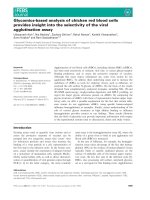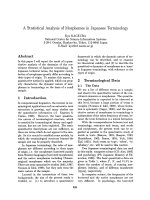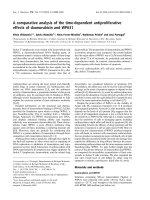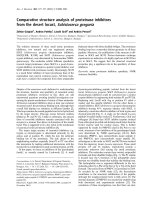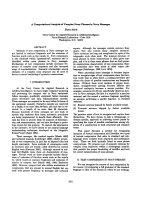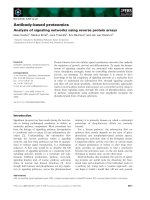Báo cáo khoa học: Antibody-based proteomics Analysis of signaling networks using reverse protein arrays pdf
Bạn đang xem bản rút gọn của tài liệu. Xem và tải ngay bản đầy đủ của tài liệu tại đây (482.26 KB, 9 trang )
REVIEW ARTICLE
Antibody-based proteomics
Analysis of signaling networks using reverse protein arrays
Hans Voshol
1
, Markus Ehrat
2
, Jens Traenkle
2
, Eric Bertrand
1
and Jan van Oostrum
2
1 Novartis Institutes for BioMedical Research, Basel, Switzerland
2 Zeptosens [a division of Bayer (Schweiz) AG], Witterswil, Switzerland
Introduction
Significant progress has been made during the last dec-
ade in linking pathological conditions to defects in
molecular pathway components. Most prominent has
been the linkage of signalling pathway dysregulation
to conditions such as cancer [1] and inflammatory dis-
orders [2]. Understanding the information flow
through the various pathways within a signaling
network, and how these pathways can best be manipu-
lated to redirect signal transduction, is a challenging
endeavor. A first step would be to describe the full
complexity of signaling networks at a molecular level,
including activities specific to a particular cell type,
dynamic feedback mechanisms, pathway cross-talk,
signaling kinetics and, of course, pathway activation
states in normal and disease situations [3]. Even
though both kinases and phosphatases are key regula-
tors in signaling pathways, across the pharmaceutical
industry it is primarily kinases on which a substantial
percentage of drug-discovery efforts are currently
focused.
For a ‘kinase pathway’, the information flow (or
pathway flux) mostly depends on the ratio of phos-
phorylated and nonphosphorylated protein species,
reflecting the activation state of the biological system.
Comparing cellular activity over time, at various stages
of disease progression or before or after drug treat-
ment, provides an opportunity to find a correlation
between the activation state, on the one hand, and the
biological or disease state, on the other hand.
Small molecules that modulate the activity of signal-
ing proteins are useful tools for dissecting the func-
tional roles and connections of the individual nodes in
a pathway [4]. Using such a ‘systems approach’, one
can begin to build a model that will not only provide
Keywords
antibodies; pathways; phosphoproteomics;
protein arrays; signalling networks
Correspondence
J. van Oostrum, Zeptosens, Benkenstrasse
254, CH-4108 Witterswil, Switzerland
Fax: +41 61 726 81 70
Tel: +41 61 726 81 87
E-mail:
(Received 11 June 2009, revised 16
September 2009, accepted 22 September
2009)
doi:10.1111/j.1742-4658.2009.07395.x
Protein kinases drive the cellular signal transduction networks that underlie
the regulation of growth, survival and differentiation. To repair the deregu-
lations of signaling cascades that are associated with numerous disease
states, therapeutic strategies, based on controlling aberrant protein kinase
activity, are emerging. To develop such therapies it is crucial to have
knowledge of the full complexity of signaling networks at a molecular level
in order to understand the information flow through signaling cascades
and their cell and tissue specificity. Antibody-based proteomic approaches
(such as reverse-phase protein microarrays) are a powerful tool for using to
obtain those signaling maps, through the study of phosphorylation states
of pathway components using antibodies that specifically recognize the
phosphorylated form of kinase substrates.
Abbreviations
ERK, extracellular signal-regulated kinase; MEK, mitogen-activated protein kinase/ERK kinase; RPA, reverse (phase) protein (micro)array.
FEBS Journal 276 (2009) 6871–6879 ª 2009 The Authors Journal compilation ª 2009 FEBS 6871
a contextual understanding of the molecular mecha-
nisms of disease, but also has the potential to facilitate
the validation of therapeutic modulation of regulatory
networks [5,6]. A direct benefit of such an approach
would be the early recognition of ‘off target’ and side
effects of drug candidates [7], as well as the identifica-
tion of putative biomarkers.
The phosphorylation status of signaling pathway
components can be measured using anti-phosphopro-
tein Igs that specifically recognize their phosphorylated
isoforms. Thus, the activity status of multiple signaling
pathways or networks can be probed through parallel
phospho-specific analyses. While producing thousands
of western blots could (in theory) accomplish this, only
protein microarrays enable truly multiplexed analysis
by replicating the same sample many times on separate
arrays. This type of array, in which a protein extract is
immobilized and queried with antibodies or other
reagents that bind to a specific protein in the sample,
is often referred to as a reverse (phase) protein micro-
array [8–10].
Signaling pathways in health and
disease
Fundamental cellular processes are under tight control
of signaling pathways, many of which are highly con-
served across species [11]. Prominent players in these
signaling cascades are protein kinases and phosphata-
ses, which control the activation state of signaling
pathways by the modulation of phosphorylation on
Tyr, Ser and Thr residues on each other and on a vari-
ety of downstream effectors. Aberrant cellular signal-
ing is a hallmark of many diseases, and consequently
there is a substantial interest in developing drugs that
can modulate and ⁄ or repair defects in signaling path-
ways.
In general, drug discovery faces many challenges,
with perhaps the failure of drug candidates during the
development process (e.g. as a result of adverse effects
or lack of efficacy) being the most prominent one. This
high attrition rate may reflect the fact that we are only
just beginning to understand the complexity of the
response of a biological system to perturbations like a
disease state or drug treatment. Hence, a deeper
insight into the molecular mechanisms underlying both
disease processes and drug action will ultimately
contribute to an increased productivity of the drug-dis-
covery process [11–13].
In many compound development projects, different
assay systems are used for the selection and character-
ization of kinase inhibitors. Primarily, compounds are
selected with biochemical, cell-free assays using puri-
fied recombinant kinases and artificial peptide sub-
strates. Cell-based assays are used as a secondary
screening step to validate the biological activity of
selected compounds against the native kinases in their
natural environment. For kinase inhibitors, these
screens usually comprise the detection of one or a few
phosphorylated proteins that are directly related to the
action of the targeted kinase. Because of the inherent
potential promiscuity of kinase inhibitors, a more
extensive characterization of compound activities
across a wide range of signaling pathways and their
components is desirable to select the inhibitors with
the appropriate profile [7,14].
Drugs that inhibit kinases have recently entered the
market, the most spectacular example being imatinib
(Gleevec ⁄ Glivec), which inhibits the constitutive kinase
activity of the Bcr–Abl fusion protein, the product of
a chromosomal translocation in patients suffering
from chronic myelogenous leukemia. Several other
kinase inhibitors are already on the market, for exam-
ple erlotinib (Tarceva) and gefitinib (Iressa), both of
which block the epidermal growth factor receptor
tyrosine kinase. Tyrosine kinase inhibitors act by
inhibiting the activation of intracellular signal trans-
duction, typically by blockage of the ATP-binding site
in the catalytic domain of the kinase. As the majority
of kinase inhibitors that are discovered by high-
throughput screening methods target the ATP-binding
pocket of the kinase, there is an inherent selectivity
problem. Even though these ATP-binding sites, and
the surrounding areas, differ between kinases, there is
enough similarity to make it very difficult, if not
impossible, to develop a fully selective compound for
each target. While at first glance this lack of specific-
ity, or ‘promiscuity’ [15], appears to be an obstacle for
developing a successful drug, in the case of imatinib it
has resulted in approval for the treatment of gastroin-
testinal stromal tumors, owing to its inhibitory activity
against c-kit, the protein tyrosine kinase that is dys-
regulated in that cancer. Nevertheless, profiling kinase
inhibitors for potential secondary targets is an essen-
tial and integral part of drug development so that
compounds with a desired (usually narrow) target pro-
file can be prioritized over those that are less ‘clean’
and potentially more risky.
From biochemical assays to pathway
readouts for kinase activity
Profiling of kinase inhibitors can be useful to assess
the promiscuity of the inhibitor and how much of a
problem that might present. The first published
screens of that kind emphasized the importance of
Analysis of signaling networks using protein arrays H. Voshol et al.
6872 FEBS Journal 276 (2009) 6871–6879 ª 2009 The Authors Journal compilation ª 2009 FEBS
such assays, showing that many commercial inhibitors
were everything but specific for the target they claimed
to hit [16,17]. The availability of the human genome
and the subsequent prediction of the ‘kinome’, the
complete set of some 500 human kinases [18], have
further accelerated the development of kinase panels.
Currently, such collections comprise over 250 kinases;
in other words, around half of the human kinome.
While the interaction with, and inhibition of, kinases
in vitro is one important aspect of profiling com-
pounds, it does not take into account the complexity
of the in vivo situation, where compounds encounter a
wide variety of potential interactors, both kinases and
nonkinases.
Consequently, cellular assays, preferably in a cell
type that is a reasonable proxy for the targeted popu-
lation, are preferred. Here, two basic approaches have
emerged. On the one hand there are the ‘chemical
proteomics’ (or chemoproteomics) approaches, which
determine protein–compound interaction rather than
measuring actual inhibition of the enzymatic activity.
In chemical proteomics, the kinase inhibitor in ques-
tion is immobilized and used as ‘bait’ to fish for
interacting proteins in cell or tissue lysates [19].
Alternatively, tracing the functional effects of
compounds in cellular systems can be studied using
pathway proteomics approaches (Fig. 1).
The last, and undoubtedly most important, piece of
the puzzle when it comes to determining selectivity and
specificity of kinase inhibitors, or ultimately any class
of drugs, is to develop a meaningful assay for the
physiological effect of a compound as early as possible
in drug discovery. Ideally such an assay would com-
bine readouts for the two most relevant parameters
that determine the potential of a compound as a drug,
namely (a) the on-target activity as the primary mea-
sure for pharmacological efficacy and (b) the off-target
effects, which should be minimized in order to obtain
a ‘clean’ compound with the smallest risk of side
effects. As the example of imatinib has shown, on-tar-
get and off-target effects do not always correlate so
strictly with beneficial and adverse effects as one would
like [20]. Nevertheless, understanding and discriminat-
ing the physiological changes that are inevitable (i.e.
because of interaction with the primary target) from
those that might be undesirable and avoidable is a key
asset in selecting the best possible compound. To
achieve that, the choice of a suitable set of readouts
with the appropriate resolution or granularity is criti-
cal. One could resort to monitoring as many individual
cellular components – genes, proteins, metabolites – as
possible. Arguably, signaling pathways are currently
the best practical translation of ‘physiology’ because
they allow a sufficient level of granularity while inte-
grating the basic organizing principles of the cellular
machinery at the same time [11].
Multiple assay formats have evolved for measuring
pathway activity, varying in information content and
throughput. The principle that all these assays have in
common is that they attempt to measure the relative
activation state of proteins in pathways. Because in the
majority of cases these proteins are kinases and their
activity is regulated by phosphorylation, most assay
formats are based on multiplexed or parallel detection
of specific phosphorylation sites.
The phosphorylation status of signaling pathway
components can be measured using anti-phosphopro-
tein Igs that specifically recognize the phosphorylated
isoforms of such kinase substrates [5,21]. For example,
quantitative data sets measuring the effects of kinase
inhibition on the phosphorylation status of pathway
components may be obtained using a compound titra-
tion series (Fig. 1). A concentration–response analysis
allows the calculation of the half maximum effective
concentration (EC
50
) as a reliable quantitative descrip-
tion of the phosphorylation changes. Thus, the activity
status of multiple signaling pathways can be probed
through parallel phosphospecific analysis. Besides the
laborious western blot, which allows only a limited
throughput, the current gold standard for this purpose
is the sandwich ELISA, which is available in many
custom or commercial formats. Sandwich ELISAs
have the disadvantage that a carefully matched pair of
antibodies must be developed if one aims for site-spe-
cific analysis. Moreover, the (peptide) epitopes that
have been used for the generation of antibodies are
not always accessible in the native (nondenatured)
protein.
Recently, lysate arrays have emerged as an alterna-
tive to the sandwich (or forward) assay format [10].
This type of array, in which a protein extract is immo-
bilized and queried with antibodies or other reagents
that bind to a specific protein in the sample, is often
referred to as reverse (phase) protein (micro)array
(RPA). The term ‘reverse’ serves to contrast the lysate
array format with ‘forward arrays’, namely those in
which the capture reagent (e.g. the antibody) is immo-
bilized [22,23]. Among the first applications of RPA
were microarrays of tissue lysates to study many
proteins in microdissected biopsies [8].
RPAs have been used for several years in their most
basic form, the dot-blot, in which drops of cell or tis-
sue extract are applied to a membrane or a coated
glass slide. Among the different proteomics technolo-
gies that are suitable for that purpose, we employ a
reverse array platform utilizing the planar waveguide
H. Voshol et al. Analysis of signaling networks using protein arrays
FEBS Journal 276 (2009) 6871–6879 ª 2009 The Authors Journal compilation ª 2009 FEBS 6873
technology that allows the detection of a minimum of
1000–2000 molecules present in a single spot, where
the total protein content of a single spot corresponds
to that of a single cell [9]. Cells or tissue samples are
subjected to a one-step extraction using denaturing
conditions, under which the potentially labile protein
phosphorylations are effectively ‘frozen’, rendering
most peptide epitopes accessible and making it rela-
tively easy to translate antibody validation by western
blotting into an array format.
Although RPAs have gained popularity as an alter-
native to classical western blots because of a dramati-
cally increased throughput, the major bottleneck, as
with most antibody-based proteomics approaches,
remains the validation of antibodies, which should be
highly specific and should not cross-react with any
other protein in the cell lysate. As the quality of the
antibodies is key to the successful application of
RPAs, significant effort is required to ensure their
validation before they are applied.
Analysis of signaling pathways using
RPAs
In our view, RPAs currently provide the best array-
based pathway analysis platform when information
content and flexibility are the primary criteria. In con-
trast to classical (forward) arrays, reverse arrays are,
in fact, high-throughput dot-blots: small droplets of
the complete protein extract are spotted onto a hydro-
phobic surface, which retains the proteins by adhesion.
Usually, whole tissue or cell extracts, corresponding to
the whole cellular proteome, are spotted. RPA
approaches often utilize denaturing extraction buffer
systems [24,25], which have the important advantage
that artifacts caused by inappropriate enzyme activity
during extraction can be largely avoided [26]. In this
regard, forward array systems are more challenging
because the capture step is typically carried out under
native conditions, with the inherent risks of artificial
changes in the extracts, particularly in labile phospho-
MEK
Erk
Ras/Raf
MEKMEK
p90RSK
Erk
p90RSK
EGFR
AB
Fig. 1. Monitoring of downstream cell sig-
naling effects upon kinase inhibition. A375
cells were treated with increasing concen-
trations of a Raf inhibitor. Cells were lysed
and the phosphorylation levels of the down-
stream pathway elements, mitogen-acti-
vated protein kinase/ERK kinase (MEK),
extracellular signal-regulated kinase (ERK)
and p90RSK were monitored using phos-
phospecific antibodies on reverse protein
arrays. By plotting the percentage activity
(inhibition of phosphorylation) versus inhibi-
tor concentration one can derive half maxi-
mum effective concentration (EC
50
)-like data
for each pathway element from such experi-
ments. Western blots of replicate samples
are shown together with the quantitative
EC
50
curves. RFI, referenced fluorescence
intensity.
Analysis of signaling networks using protein arrays H. Voshol et al.
6874 FEBS Journal 276 (2009) 6871–6879 ª 2009 The Authors Journal compilation ª 2009 FEBS
rylations. Analogous to western blots and dot-blots,
nitrocellulose was originally used as the carrier for
RPAs, albeit in the form of nitrocellulose-coated chips
[8], to facilitate handling and scanning. In efforts to
obtain the ideal surface, which should combine high
protein binding with low intrinsic background [24],
other materials and techniques have been explored,
including methodology derived from semiconductor
fabrication [24]. Arguably the most advanced, commer-
cially available, substrate for reverse arrays is the
ZeptoCHIP. This device combines a hydrophobic coat-
ing (to ensure firm adhesion of proteins) with planar
waveguide technology, which allows for enhanced sen-
sitivity compared with conventional scanners [27]. The
principle of the planar waveguide is to propagate the
laser light of the scanner along the chip surface, result-
ing in minimal background from nonsurface-bound
molecules (Fig. 2A). Because proteins interact with this
reverse array surface in a noncovalent manner, the
actual composition of the spots depends on the com-
position of the lysates, the lysis buffer and the ‘affinity’
of the individual proteins for the solid phase. Varia-
tions in lysis and spotting buffers, and in protein
concentrations, will influence the make-up of the
immobilized ‘proteome’ [25,26]. Consequently, samples
with a few highly abundant proteins, such as serum or
plasma, are more challenging to deal with than cell or
tissue lysates, where the dynamic range is less extreme.
Even though limited multiplexing is possible (e.g. using
antibodies with different fluorescent dyes), reverse
arrays are typically not used in a multiplexing mode
but mostly with only a single antibody per array. This
circumvents some of the issues inherent to multiplexing
as it is often used in forward arrays [24]. Because it is
straightforward to print many identical arrays, RPAs
nevertheless allow testing of a practically unlimited
number of antibodies in a parallel set up.
ZeptoCHIPs, which use the planar waveguide tech-
nology for improved sensitivity, are made of planar
waveguides consisting of a thin film (150 nm) of mate-
rial with a high refractive index (e.g. Ta
2
O
5
), which is
deposited on a transparent support with a lower
refractive index, typically glass. A laser light beam is
coupled into the waveguiding film by a diffractive grat-
ing that is etched into the glass. The light propagates
within this film and creates a strong evanescent field,
Separation of excitation and detection directions
Signal/noise =
2/1
Signal/noise =
200/1
Confocal excitation Evanescent excitation
A
B
Evanescent
excitation intensity
Confocal excitation
intensity
PWG principle
C
Fig. 2. (A) Planar waveguide (PWG) principle; optical scheme of excitation and detection of surface confined fluorescence on planar wave-
guide chips. (B) Fluorescence excitation schemes for conventional, confocal scanning leading to background contributions, and for evanes-
cent, surface-confined illumination using planar waveguides resulting in reduced background signals. (C) Comparison of signal-to-noise ratios
from the same microarray obtained by confocal scanning and surface-confined PWG-based fluorescent detection.
H. Voshol et al. Analysis of signaling networks using protein arrays
FEBS Journal 276 (2009) 6871–6879 ª 2009 The Authors Journal compilation ª 2009 FEBS 6875
perpendicular to the direction of propagation, into the
adjacent medium (Fig. 2A). Upon fluorescence excita-
tion by the evanescent field, excitation and detection of
fluorophores is restricted to the sensing surface, while
signals from unbound molecules in the bulk solution
are not detected (Fig. 2b). This results in a significant
increase in the signal-to-noise ratio compared with
conventional optical detection methods (Fig. 2c).
A typical microarray is a ZeptoCHIP, which has
space for six arrays, each comprising 352 spots (Fig. 3).
Each array has four columns of spots that are used to
calibrate the energy loss when the light travels across
the waveguide. Typically, 32 samples are spotted in
four dilutions (ensuring one remains always within the
linear part of the binding curve, see above) and in
duplicate. Each array is probed with a single antibody.
Each spot will have a volume of around 0.5 nL (with a
diameter of 100 lm) and will contain the amount of
protein contained in a single cell. Spotting is performed
using a noncontact piezo-electric spotter (inkjet tech-
nology), with a spotting capacity of about 360 arrays
(enabling probing with 360 antibodies) in one overnight
spotting run. After printing, the chips are blocked with
albumin (as done for western blots) and can be stored
in this blocked state for longer than 1 year at 4 °C.
RPA applications
The RPA approach was pioneered, among others, by
Liotta and Petricoin [8], driven by the need for an
analytical tool to identify signaling proteins in minute
tissue samples, such as those derived from laser-cap-
ture microdissection. Hence, RPA followed an atypical
trajectory, in a sense the opposite of most bioanalytical
tools, which are usually extensively used in model
systems before being applied on animal or human
tissue samples. Initial clinical applications were aiming
particularly at screening pathway-activation states in
tumor tissue samples, using antibodies specific for
phosphorylated proteins. The underlying hypothesis of
those experiments was that differences in these path-
way profiles could help to stratify patients and predict
response to drug treatment. Several studies have
indeed provided indications that this could be a prom-
ising avenue. For example, when studying fine needle
aspirates from breast tumors using RPA, Rapkiewicz
et al. [28] observed modulation of survival ⁄ apoptosis
and growth factor pathways as a function of previous
chemotherapy treatment.
However, elucidation of signaling pathways (i.e.
understanding how the signal is transmitted through the
cell and what the critical ‘nodes’ are), requires the inves-
tigation of (cellular) model systems. RPA applications
in model systems (e.g. compound profiling in cell-based
models) are only just starting to emerge [7]. Whereas a
cell-based (in vitro) system can easily be manipulated to
increase the amplitude of the signal, in many in vivo
situations the effects of altered signaling will be
attenuated by steady-state compensatory mechanisms.
Molecular profiling with gene arrays has provided
insight into the expression levels for genes in a variety
of normal and diseased tissue specimens. However,
gene transcript levels do not necessarily correlate with
protein expression levels and, more importantly, do
e.g sample #1
Controls
Column with reference spots
A
B
0 50 100 150
Reference
Reference
Fluorescence
Distance (pixel)
Line profile (as depicted in image)
Fig. 3. (A) Illustration of one of the six arrays on a ZeptoCHIP. On
a single array, 32 samples are spotted in four different concentra-
tions and in duplicate. (B) Scan of an array cross-section showing
the signal linearity for the four different sample concentrations.
Analysis of signaling networks using protein arrays H. Voshol et al.
6876 FEBS Journal 276 (2009) 6871–6879 ª 2009 The Authors Journal compilation ª 2009 FEBS
not provide insight into the levels of post-translational
modifications of proteins, such as phoshorylation
events, that play a significant role in cellular signaling
networks. Investigations into the protein and phospho-
protein expression levels in normal tissue would be a
prerequisite to understand the alterations in signaling
that are observed in diseased tissues and ⁄ or are caused
by in vivo treatment with specific compounds. Mouse
models are particularly useful for studying the effects
of compounds in complex organisms, helping to gain
new knowledge about the molecular mechanisms of
disease. The creation of a pathway activity atlas for
canonical signaling events would begin with the estab-
lishment of the expression levels of proteins involved
in various organs or tissues. Figure 4A represents a
small excerpt from data derived from quantitative pro-
tein expression profiling using RPAs in a collection of
tissues derived from C57 ⁄ Bl6 mice. Tissues were
extracted in a 10-fold excess of Zeptosens CLB1 buffer
using a Teflon Potter (8–10 strokes at 800 rpm) fol-
lowed by centrifugation (20 min at 100 000 g)to
remove insoluble material. Tissue lysates were stored
at )80 °C before performing RPA analysis, as
described previously [8].
The range of protein expression values within a
group of animals will provide a range of normal values
for protein expression for the corresponding organs
and tissues. Figure 4B underlines the extent of biologi-
cal variation in the expression levels of proteins and
their phosphorylated forms between two different tis-
pAkt (Ser473)
0
200
400
600
800
1000
1200
1400
Muscle
Heart
Liver
Pancreas
Kidney
Colon
Intestine
Stomach
Prostate
Frontal cortex
Hippocampus
Amygdala
Hypothalamus
Cerebellum
Thalamus
Intensity
P44/42 MAP kinase
0
2000
4000
6000
8000
10 000
12 000
14 000
Intensity
pMEK1/2 (Ser 217/221)
0
1000
2000
3000
4000
5000
6000
Intensity
Glycogen synthase
0
1000
2000
3000
4000
5000
6000
7000
8000
Intensity
A
B
0
500
1000
1500
2000
2500
3000
3500
Heart 1
Heart 2
Heart 3
Heart 4
Heart 5
Heart 6
Heart 7
Heart 8
Pancreas 1
Pancreas 2
Pancreas 3
Pancreas 4
Pancreas 5
Pancreas 6
Pancreas 7
Pancreas 8
GSK-3β
0
200
400
600
800
1000
1200
1400
Heart 1
Heart 2
Heart 3
Heart 4
Heart 5
Heart 6
Heart 7
Heart 8
Pancreas 1
Pancreas 2
Pancreas 3
Pancreas 4
Pancreas 5
Pancreas 6
Pancreas 7
Pancreas 8
GSK-3α
0
500
1000
1500
2000
2500
3000
3500
Heart 1
Heart 2
Heart 3
Heart 4
Heart 5
Heart 6
Heart 7
Heart 8
Pancreas 1
Pancreas 2
Pancreas 3
Pancreas 4
Pancreas 5
Pancreas 6
Pancreas 7
Pancreas 8
p70 S6 Kinase
0
500
1000
1500
2000
2500
3000
3500
4000
Heart 1
Heart 2
Heart 3
Heart 4
Heart 5
Heart 6
Heart 7
Heart 8
Pancreas 1
Pancreas 2
Pancreas 3
Pancreas 4
Pancreas 5
Pancreas 6
Pancreas 7
Pancreas 8
TSC-2
0
500
1000
1500
2000
2500
Heart 1
Heart 2
Heart 3
Heart 4
Heart 5
Heart 6
Heart 7
Heart 8
Pancreas 1
Pancreas 2
Pancreas 3
Pancreas 4
Pancreas 5
Pancreas 6
Pancreas 7
Pancreas 8
Phospho-PTEN
0
500
1000
1500
2000
2500
Heart 1
Heart 2
Heart 3
Heart 4
Heart 5
Heart 6
Heart 7
Heart 8
Pancreas 1
Pancreas 2
Pancreas 3
Pancreas 4
Pancreas 5
Pancreas 6
Pancreas 7
Pancreas 8
Phospho-mTOR
0
1000
2000
3000
4000
5000
6000
7000
8000
Heart 1
Heart 2
Heart 3
Heart 4
Heart 5
Heart 6
Heart 7
Heart 8
Pancreas 1
Pancreas 2
Pancreas 3
Pancreas 4
Pancreas 5
Pancreas 6
Pancreas 7
Pancreas 8
Phospho-p44/42 MAPK
0
500
1000
1500
2000
2500
3000
Heart 1
Heart 2
Heart 3
Heart 4
Heart 5
Heart 6
Heart 7
Heart 8
Pancreas 1
Pancreas 2
Pancreas 3
Pancreas 4
Pancreas 5
Pancreas 6
Pancreas 7
Pancreas 8
Phospho-β-Catenin
Fig. 4. Towards a protein expression atlas. (A) Relative expression levels of selected signaling network components in mouse organs and
brain areas. (B) Relative expression levels of selected signaling network components from the heart and pancreas derived from eight
C57 ⁄ B6 mice.
H. Voshol et al. Analysis of signaling networks using protein arrays
FEBS Journal 276 (2009) 6871–6879 ª 2009 The Authors Journal compilation ª 2009 FEBS 6877
sues within a group of eight different C57 ⁄ Bl6 mice. A
second step would involve the measurement of the
activity levels of signaling pathways, indicated by, for
example, the phospho- ⁄ nonphospho ratios of pathway
components. We envisage that ultimately building such
activation maps across organs will be highly valuable
in the development of drugs that target cellular signal-
ing networks. The idea behind this concept, which we
refer to as predictive pharmacodynamics, is that the
activation map of the targeted pathway could serve to
select the optimal intervention point, which is actually
likely to differ depending on the target tissue. At the
very least, this approach would deliver useful pharma-
codynamic markers to monitor the effects of different
compounds in the organism. Moreover, at least in the-
ory, this methodology for selecting the correct target
would have both the benefit of maximizing the thera-
peutic effect as well as minimizing adverse events.
Conclusion
Owing to the high sensitivity and high throughput
capability of the RPA approach, it will be feasible to
obtain protein expression profiles and signaling path-
way information on a wide variety of cell lines and
tissue samples. Interesting applications include (a) the
comparative analysis of signaling pathway(s) events in
normal versus diseased tissue, (b) the comparative
analysis of protein expression in various systems, (c)
elucidation of the dynamic aspects of pathway events
and (d) the profiling of compounds to reveal signaling
and cross-pathway effects of drug candidates. In addi-
tion, analysis of healthy versus diseased tissue (includ-
ing animal models) will provide insights into the
underlying pathologies of the pathways and provide a
platform for molecular diagnostics. In a future
approach, the screening of body fluids with a reverse
array approach may enable the investigation of a large
number of individual body fluid samples for a limited
set of proteins contained within them, to establish
variations in protein expression levels.
Acknowledgements
The authors would like to acknowledge Dr A. van Gool
(Schering-Plough, Translational Medicine Research
Centre, Singapore) for providing the western blot results
shown in Fig. 1.
References
1 Blume-Jensen P & Hunter T (2001) Oncogenic kinase
signaling. Nature 411, 355–365.
2 Ohashi PS (2002) T-cell signaling and autoimmunity;
molecular mechanisms of disease. Nat Rev Immunol 2,
427–438.
3 Hopkins AL (2008) Network pharmacology: the next
paradigm in drug discovery. Nat Chem Biol 4, 682–690.
4 Sevecka M and MacBeath G (2006) State-based discov-
ery: a multidimensional screen for small-molecule mod-
ulators of EGF signaling. Nat Methods 3, 825–831.
5 Cho C, Labow M, Reinhardt M, van Oostrum J & Pei-
tsch MC (2006) The application of systems biology
to drug discovery. Curr Opin Chem Biol 10, 294–302.
6 Jia J, Zhu F, Ma X, Cao ZW, Li YX & Chen YZ
(2009) Mechanisms of drug combinations:interactions
and network perspectives. Nat Rev Drug Discov 8,
111–128.
7 Van Oostrum J, Calonder C, Rechsteiner D, Ehrat M,
Mestan J, Fabbro D & Voshol H (2009) Tracing path-
way activities with kinase inhibitors and reverse phase
protein arrays. Proteomics Clin Appl 3, 412–422.
8 Pawaletz CP, Charboneau L, Bichsel VE, Simone NL,
Chen T, Gillespie JW, Emmert-Buck MR, Roth MJ,
Petricoin EF III & Liotta LA (2001) Reverse phase pro-
tein microarrays which capture disease progression
show activation of pro-survival pathways at the cancer
invasion front. Oncogene 20, 1981–1989.
9 Pawlak M, Schick E, Bopp MA, Schneider MJ, Orozlan
P & Ehrat M (2002) Zeptosens’ protein microarrays: a
novel high performance microarray platform for low
abundance protein analysis. Proteomics 2, 383–393.
10 Sheehan KM, Calvert VS, Kay EW, Lu Y, Fishman D,
Espina V, Aquino J, Speer R, Araujo R, Mills GB et al.
(2005) Use of reverse phase protein microarrays and
reference standard develoment for moilecular network
analysis of metastatic ovarian carcinoma. Mol Cell
Proteomics 4, 346–355.
11 Fishman MC & Porter JA (2005) A new grammar for
drug discovery. Nature 437, 491–493.
12 Butcher EC, Berg EL & Kunkel EJ (2004) Systems
biology in drug discovery. Nat Biotechnol 22, 1253–1259.
13 Apic G, Ignjatovic T, Boyer S & Russel RB (2005) Illu-
minating drug discovery with biological pathways.
FEBS Lett 579, 1872–1877.
14 Araujo RP, Liotta LA & Petricoin EF (2007) Proteins,
drug targets and the mechanisms they control: the sim-
ple truth about complex analysis. Nat Rev Drug Discov
6, 871–880.
15 Zhang J, Yang PL & Gray NS (2009) Targeting cancer
with small molecule kinase inhibitors. Nat Rev Cancer
9, 28–39.
16 Davies SP, Reddy H, Caivano M & Cohen P (2000)
Specificity and mechanism of action of some
commonly used protein kinase inhibitors. Biochem J
351, 95–105.
17 Bain J, Plater L, Elliot M, Shpiro N, Hastie CJ,
McLauchlan H, Klevernic I, Arthur JSC, Alessi DR &
Analysis of signaling networks using protein arrays H. Voshol et al.
6878 FEBS Journal 276 (2009) 6871–6879 ª 2009 The Authors Journal compilation ª 2009 FEBS
Cohen P (2007) The selectivity of protein kinase inhibi-
tors. a further update. Biochem J 408, 297–315.
18 Manning G, Whyte DB, Martinez R, Hunter T &
Sudarsanam S (2002) The protein kinase complement
of the human genome. Science 298, 1912–1934.
19 Daub H, Godl K, Brehmer D, Klebl B & Mu
¨
ller G
(2004) Evaluation of kinase inhibitor selectivity by
chemical proteomics. Assay Drug Dev Technol 2, 215–
224.
20 Petrelli A & Giordano S (2008) From single- to multi-
target drugs in cancer therapy: when aspecificity
becomes an advantage. Curr Med Chem 15, 422–432.
21 Mendes KN, Nicorici D, Cogdell D, Tabus I, Yli-Harja
O, Guerra R, Hamilton SR & Zhang W (2007) Analysis
of signaling pathways in 90 cancer cell lines by protein
lysate arrays. J Proteome Res 6, 2753–2767.
22 Borrebaeck CAK & Wingren C (2007) High throughput
proteomics using antibody microarrays: an update.
Expert Rev Mol Diagn 7, 673–686.
23 Haab BB (2005) Antibody arrays in cancer research.
Mol Cell Proteomics 4, 377–383.
24 VanMeter A, Signore M, Pierobon M, Espina V, Liotta
LA & Petricoin EF III (2007) Reverse-phase protein
microarrays: application to biomarker discovery and
translational medicine. Expert Rev Mol Diagn 7,
625–633.
25 Winters M, Dabir B, Yu M & Kohn EC (2007)
Constitution and quantity of lysis buffer alters outcome
of reverse phase protein microarrays. Proteomics 22,
4066–4068.
26 Gromov P, Celis JE, Gromova I, Rank F, Timmer-
mans-Wielinga V & Moreira JMA (2008) A single lysis
solution for the analysis of tissue samples by different
proteomic technologies. Mol Oncol 2, 368–379.
27 Ghatnekar-Nilsson S, Dexlin L, Wingren C, Montelius
L & Borrebaeck CAK (2007) Design of atto-vial
based recombinant antibody arrays combined with a
planar waveguide detection system. Proteomics 7,
540–547.
28 Rapkiewicz A, Espina V, Zujewski JA, Lebowitz PF,
Filie A, Wulfkuhle J, Camphausen K, Petricoin EF III,
Liotta LA & Abati A (2007) The needle in the
haystack:application of breast fine-needle aspirate
samples to quantitative protein microarray technology.
Cancer Cytopathol 111, 173–184.
H. Voshol et al. Analysis of signaling networks using protein arrays
FEBS Journal 276 (2009) 6871–6879 ª 2009 The Authors Journal compilation ª 2009 FEBS 6879
